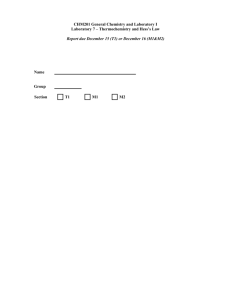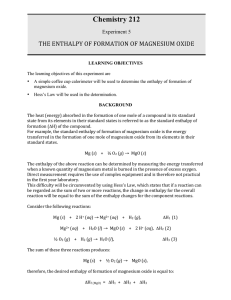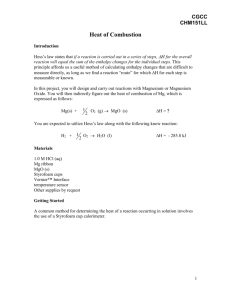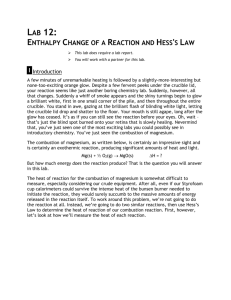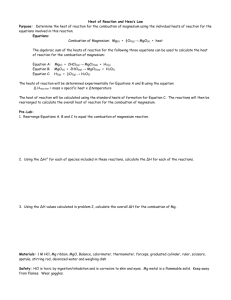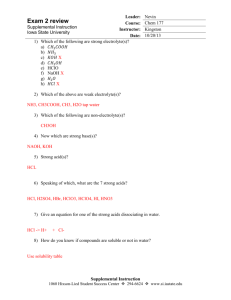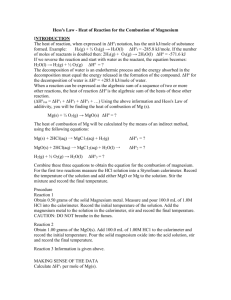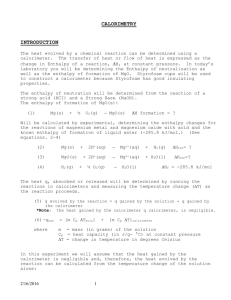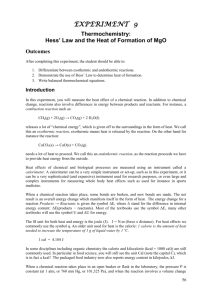Enthalpy of Formation of MgO Lab Experiment
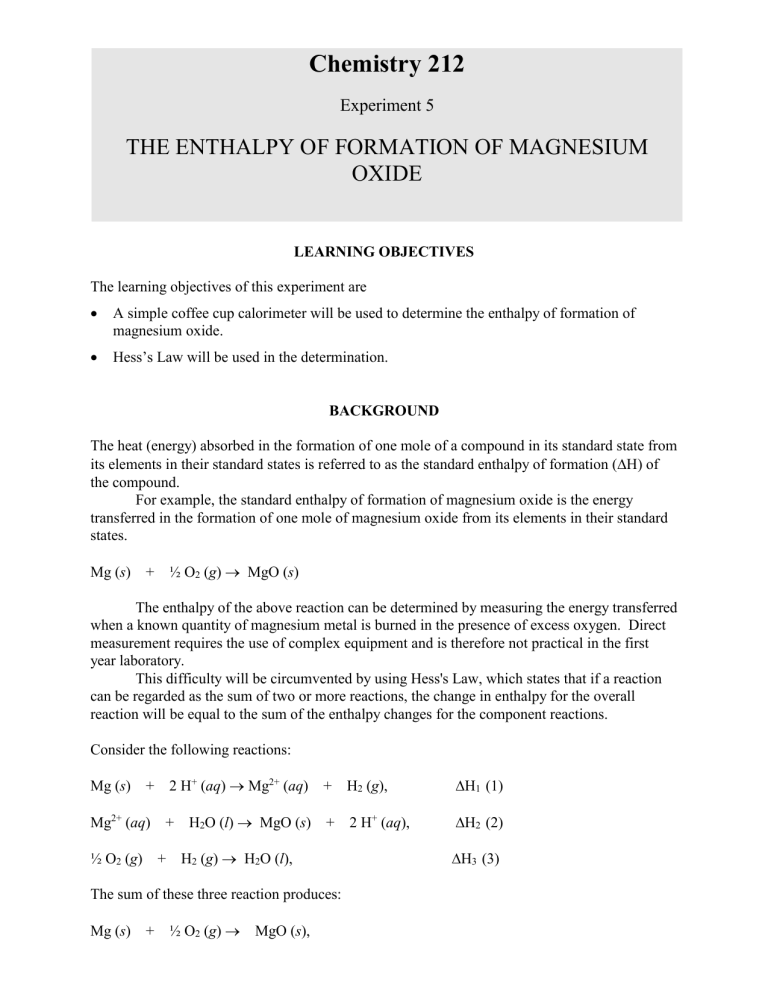
Chemistry 212
Experiment 5
THE ENTHALPY OF FORMATION OF MAGNESIUM
OXIDE
LEARNING OBJECTIVES
The learning objectives of this experiment are
A simple coffee cup calorimeter will be used to determine the enthalpy of formation of magnesium oxide.
Hess’s Law will be used in the determination.
BACKGROUND
The heat (energy) absorbed in the formation of one mole of a compound in its standard state from its elements in their standard states is referred to as the standard enthalpy of formation (
H) of the compound.
For example, the standard enthalpy of formation of magnesium oxide is the energy transferred in the formation of one mole of magnesium oxide from its elements in their standard states.
Mg ( s
) + ½ O
2
( g )
MgO ( s )
The enthalpy of the above reaction can be determined by measuring the energy transferred when a known quantity of magnesium metal is burned in the presence of excess oxygen. Direct measurement requires the use of complex equipment and is therefore not practical in the first year laboratory.
This difficulty will be circumvented by using Hess's Law, which states that if a reaction can be regarded as the sum of two or more reactions, the change in enthalpy for the overall reaction will be equal to the sum of the enthalpy changes for the component reactions.
Consider the following reactions:
Mg ( s ) + 2 H
+
( aq )
Mg
2+
( aq ) + H
2
( g ),
H
1
(1)
Mg 2+ ( aq ) + H
2
O ( l )
MgO ( s ) + 2 H + ( aq ),
½ O
2
( g ) + H
2
( g )
H
2
O ( l ),
The sum of these three reaction produces:
H
H
2
3
(2)
(3)
Mg ( s
) + ½ O
2
( g )
MgO ( s ),
therefore, the desired enthalpy of formation of magnesium oxide is equal to:
H f (MgO)
=
H
1
+
H
2
+
H
3
In this experiment,
H
1
will be determined by measuring the energy released when a known quantity of magnesium metal is reacted with a slight excess of hydrochloric acid.
Mg ( s ) + 2 H + ( aq )
Mg 2+ ( aq ) + H
2
( g ),
H
1
The reverse of H
2
will be determined by measuring the energy released when magnesium oxide is dissolved in hydrochloric acid.
MgO ( s ) + 2 H
+
( aq )
Mg
2+
( aq ) + H
2
O ( l ), -
H
2
The heat of formation of water,
H
3
, is readily available in scientific literature.
Reactions (1) and (2) will be completed in aqueous solution in the lab. An energy transfer will occur between the reacting species and the solution in which the reaction takes place. This energy transfer will cause a resulting increase (or decrease) in the temperature of the solution. The assumption is made that all energy transfer is in the form of heat. Also, assume that the density of the HCl solution is 1.00 g/mL .
The specific heat capacity of water is 4.184 J C
-1 g
-1
. It takes 4.184 J (or 1 calorie) of energy to raise the temperature of one gram of water one degree Celsius.
By measuring the change in temperature of a given mass of water as a known quantity of material is reacted, it is possible to calculate the energy transferred during the reaction of that material. The energy which would be released by the reaction of one mole of the material (and thus the change in enthalpy for the reaction) can then be calculated.
One of the problems which is encountered in measuring temperature changes is that while the temperature is still rising, energy is being lost to the surroundings (by radiation and convection), and the observed temperature change will be smaller than the "true" temperature change. Completing the reaction under study in a calorimeter system such as the one illustrated below minimizes the energy loss. The loss of energy to the surroundings cannot be completely eliminated, however, and for this reason a graphical temperature correction is employed.
After the reactants have been mixed, the temperature of the reacting solution is plotted as a function of time. By extrapolating the slope of the temperature curve as the solution cools to time zero, T i
, (the instant of mixing of the reactants) the true maximum temperature, T f
, and thus the true temperature change, T f
- T i
, of the reacting solution can be determined.
06_74
Thermometer
Styrofoam cover
Styrofoam cups
Stirrer
Once the true
T is known, the energy transferred during the reaction can be calculated using the specific heat capacity of water, the mass of solution (solid + HCl) in the calorimeter, and the temperature change of the solution:
Energy transferred (Joules) = 4.184 J C
-1 g
-1
× g of solution ×
T
EXPERIMENTAL PROCEDURE
A device that is used to measure the energy evolved or absorbed during a process is called a calorimeter. In this experiment a calorimeter will be constructed from two Styrofoam cups in a fashion similar to that shown herewith another serving as a cover. Stirring can be done occasionally by gently swirling the calorimeter.
Calibration
Calibrate the thermistor with hot tap water and ice water.
Design Program
Design an experiment using EZ Program to measure temperature (thermistor, y1-axis) with respect to time (Timer-1, x-axis). Take temperature measurements every 2 seconds.
Initial temperature should be determined for all trials by measuring the temperature of the HCl.
Part A. Determination of
H
1
1.
Assemble the calorimeter as shown in the diagram (replacing the thermometer with a thermistor). Leave the top and thermistor off of the calorimeter at this point.
2.
Measure 0.550-0.600g of magnesium turnings directly into the calorimeter.
3.
Measure 60 mL of 1 M HCl into a graduated cylinder and record the volume to the nearest 0.1 mL.
4.
Dry the thermistor and place it in the acid solution.
5.
Start data collection program. This will give you the initial temperature to use in calculations.
6.
Place the thermistor in the hole in the calorimeter cover.
7.
Quickly transfer the HCl into the calorimeter and replace the cover. It will fizz vigorously, so be careful.
8.
Collect temperature data for at least 5 minutes.
9.
When the above procedure is complete, clean and dry the Styrofoam cup and repeat the procedure for a second trial.
Part B. Determination of
H
2
1.
Using the same procedure as outlined above, determine
H
2
.
2.
You should use 0.900 - 1.000 g of MgO and 60 mL of 1 M HCl.
3.
Two trials should be completed. Again, collect temperature data for at least 5 minutes.
4.
The calorimeter should be cleaned and dried between each trial.
DATA ANALYSIS
1.
A temperature vs. time curve must be plotted for each trial in order to determine the change in temperature (
T).
2.
Calculate
H
1
(kJ/mol) for each of the two trials in Part A. Calculate the mean
H
1
.
3.
Similarly, plot the data from Part B and calculate the mean
H
2
. Note that the reverse of reaction 2 was actually performed. Adjust the sign appropriately.
4.
Calculate the enthalpy of formation of magnesium oxide (kJ/mol). In your calculation, show the algebraic summation of component reactions and enthalpy values.
REPORT DETAILS
1. Summary Report Form – For conclusion, comment on the accuracy and precision of the experiment, based on your data and the class data. Also, are the assumptions that were made in the lab, i.e. the density of the HCl is 1.00 g/mL and that no heat is lost to the surroundings valid? Justify your comments.
2. Data Sheet
3. Graphs
THE ENTHALPY OF FORMATION OF MAGNESIUM OXIDE
Summary Report Sheet
Name: ______________________ Date: ____________
Results :
MgO
H f
Determinations
Experimental
H f
(kJ/mole) % Error
(Literature)
Standard deviation
Class Average
Literature
Calculations (Show error calculations here.)
Conclusion :
THE ENTHALPY OF FORMATION OF MAGNESIUM OXIDE
Data Sheet
Part A. Determination of
H
1
Quantity
Trial 1
Trial 2
Mass of Mg (g)
Moles of Mg (mol)
Mass of solution + Mg (g)
T ( o C)
Energy transferred (kJ)
H
1
(kJ/mol)
Part B. Determination of
H
2
Quantity
Trial 1
Trial 2
Mass of MgO (g)
Moles of MgO (mol)
Mg (
Mg
2+ s
(
) + 2 H aq
+
) + H
( aq )
Mg 2+ ( aq ) + H
2
O ( l )
MgO ( s
2
(
) + 2 H g
+
)
( aq )
Mass of solution + MgO (g)
T ( o
C)
Energy transferred (kJ)
H
2
(kJ/mol)
Determination of
H f
Mean
H
1
(Part A)
Mean
H
2
(Part B)
Mg ( s
) + ½ O
2
( g )
MgO ( s )
H
3
(
H, H
2
O ( l )) (from literature)
H f
, MgO ( s ) (experimental)
H f
, MgO ( s ) (from literature)
% error (of
H f
, MgO ( s ))
Class Data for
H f
of MgO
Group
1
Group
2
Group
3
Group
4
Group
5
Group
6
Group
7
Group
8
Group
9
Class
Ave.
THE ENTHALPY OF FORMATION OF MAGNESIUM OXIDE
Pre-Laboratory Questions
Name: ______________________ Section: __________ Date: ____________
1.
In a Styrofoam calorimeter, 50.0 mL of 0.100 M AgNO
3
and 50.0 mL of 0.100 M HCl are mixed. The following reaction occurs:
Ag + ( aq ) + Cl ( aq ) s )
+
( aq ) for the above reaction. Assume there is 100.0 g of
-1 g -1 .
2.
In an experiment similar to the procedure described in Part B of the lab procedure, 2.500 g of MgO were combined with 125 mL of 1.0 M HCl. The temperature increased by
Mg 2+ ( aq ) + H
2
O( l s ) + 2 H + ( aq )
